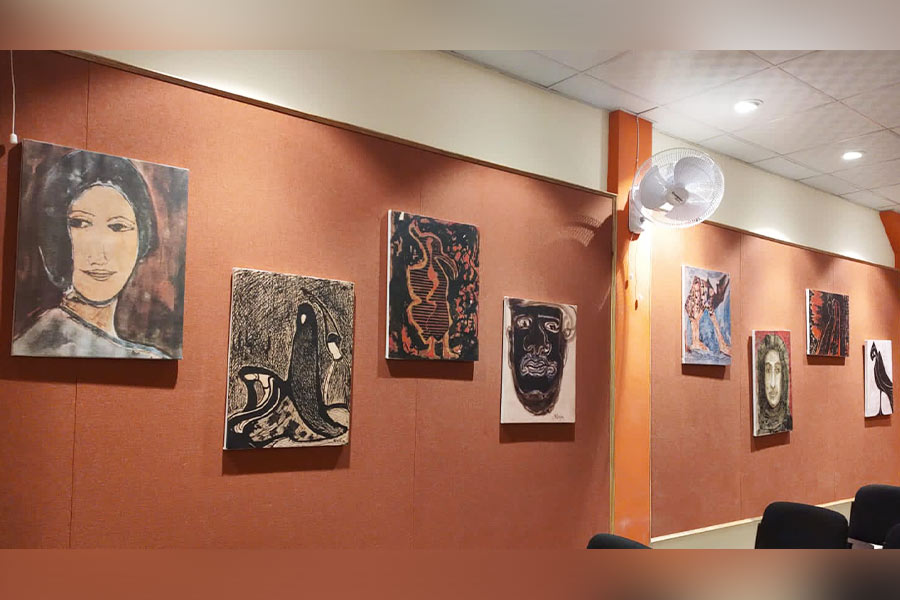The viewers are forced to view it like a traveller moving through an actual landscape,” read a line on the note adjacent to the display at the historic exhibition titled ‘Scenes from Santiniketan & Benodebehari’s Handscrolls’, held recently at Kolkata Centre for Creativity. This month-long exhibition, organised in collaboration with Gallery Rasa, was curated by art historian R. Siva Kumar that displayed for the very first time artist Benodebehari Mukherjee’s earliest and longest handscroll titled ‘Scenes from Santiniketan’. Along with this handscroll, which in a panoramic format captured the landscape of Santiniketan, visitors got an opportunity to catch a glimpse of fragments of his other existing handscrolls, including one from the collection of Victoria & Albert Museum, London.
Another highlight of the exhibition was the display of the ceiling mural, which is considered a culmination of Benodebehari Mukherjee’s landscape painting, painted in 1940 on the ceiling of his hostel verandah in Santiniketan. The exhibition was inaugurated in the presence of Rakesh Sahni, director of Gallery Rasa; Sugata Bose, professor at Harvard University’s Department of History; artist Jogen Chowdhury, art historian Pranab Ranjan Roy and art historian R. Siva Kumar. R. Siva Kumar also introduced his book Scenes from Santiniketan and Benodebehari’s Handscrolls, at the exhibition, which explains the artistic and historic details of the handscrolls.
“We began in 2017 when Rakesh (Sahni) landed upon a scroll and showed it to me to ask if I could write something. I recognised that this was the work of Benodebehari and that it could change the way people look at his work. I wrote the first draft when I was in Canada and it took me a year to finish the text. We thought we should bring together all the other scrolls and ceiling mural of Benodebehari because this is the beginning of a long journey at a time when all Indian artists were doing either mythological or historical work. Benodebehari decided to paint nature. This scroll is from 1924, when ‘landscape’ was a minor genre, and the great landscapes of Abanindranath were three years after this. In modern Indian art, the scroll represents the modern juncture. We only have fragments of the other scrolls. This is the only scroll that exists in its entirety, and this is the scroll where the totality of Santiniketan landscapes is there,” said R. Siva Kumar in his inaugural address.
One of the first students of Kala Bhavana, Benodebehari is considered a pioneer of rural landscape art. Though a student of Nandalal Bose, the landscape paintings of Benodebehari came prior to Bose’s landscape paintings. “He sums up his experience of 20 years in the mural on the ceiling. Luckily I had access to an old photograph, which was taken right after it was painted in 1940. He was the first person to move away from the historicist painting that Bengal was doing. Rabindranath urged artists to go and look at the rural landscape and the life of the people and bring that life of people to art. The only person who was sympathetic to his ideas was Nandalal. No one else paid attention to it. Benodebehari was a pioneer in rural landscape art, but the idea came from Rabindranath. This was the time when the major shifts were happening in Indian art,” continued R. Siva Kumar.
The century-old 13m horizontal scroll done in ink and watercolour brushstrokes was inspired by the format of East Asian landscape painting and ink painting. It depicts the local life and landscape of Santiniketan and captures the transformation of seasons, the stillness and movements of people and animals. “Benodebehari tells us something about the power of visual imagination, which is so much greater than what we see and that is what Satyajit Ray captured in his documentary. It is also important to talk about today how Benodebehari transcended disability. In his last years, he had lost his sight. He was like Beethoven. He continued to paint until his last days. We need to remember that Kolkata was throughout the 20th century a centre of creativity for Asian art. As a historian, I had started my work by looking at agrarian Bengal,” said Sugata Bose.
He further shared interesting snippets of Benodebehari and Nandalal Bose’s introduction to Japanese and Chinese art by great artists like Yokoyama Taikan and Xu Beihong. “Art has always been a conversation across Asia. What this exhibition shows us is Benodebehari was a pioneer amongst landscape artists and he is able to show the passage of time — the beginning of the summer and going through the changes of the season and the colours emerging... Benodebehari used to give away his paintings to friends at low rates, and that is how I believe we have access to these paintings. Artists were not well remunerated back then. This kind of artistic creativity is not just about feeling nostalgic but should instil in us the determination to recover something of what we lost and try to give a new meaning in the present. Certainly the dream of Rabindranath Tagore and also all the artists he brought to Santiniketan,” said Sugata Bose.
'Scenes from Santiniketan' is Benodebehari’s first experiment with the handscroll format and like conventional East Asian scrolls, it begins on the right and moves leftward resembling several stages of a journey — “a space shaped by the human intent towards barrenness sculpted by the elements and through several seasons”, read a note explaining it. His scrolls capture the centre of the campus, the forests, the villages, paddy fields and khoai (eroded land). “When we look at the painting, we just see the landscape of Santiniketan and we are lucky to see the past of Santiniketan. It is a great thing that we have the painting with us. The style of painting resembles a particular style of Kala Bhavana. The scrolls capture those times. There is no influence of modernism in the life captured,” said Jogen Chowdhury.
The scrolls are done in sections and the empty spaces between each section connect one to the other. The exhibition displayed fragments of other interesting scrolls too, like the khoai scroll and the village scene scroll that depicts Benodebehari’s gradually changing attitude to life and nature. The khoai scroll is a single feature of the local landscape done in shades of red and black. The representation of nature in his work continued till the 1940s and culminated in the 83cm-long ceiling mural on the verandah of his hostel.
“When we see a full house at an exhibition, we feel Kolkata is great. Today, we are bound together to pay homage to the persona and the art that is one of the pioneers of modern Indian art. I am grateful to R. Siva Kumar for the insightful essay and thoughtful curation. Collaborations are the key today, and it makes us stronger. This is the seventh collaborative exhibition of Gallery Rasa,” said Rakesh Sahni, director, Gallery Rasa.
The mural depicts a picture of Birbhum village, with flora and fauna and other aspects of rural life. It highlights his observation of the local landscape and study of the East Asian approach to pictures. It showcases the art of calligraphic image-making in the long horizontal format and is influenced by East Asian ink paintings. Satyajit Ray described the mural as “gentle yet glowing with colour” when he spotted it upon his arrival at his hostel room verandah in Kala Bhavana, soon after it was painted. ”I was a non-art student of Benodebehari Mukherjee. He used to take classes for non-artists in the evening at Kala Bhavana. Those classes did not have any syllabus, but he spoke lots and lots about so many things. There has been a long tradition of landscape art in the far east. Benodebehari took up ‘landscape’ as a genre,” concluded art historian Pranab Ranjan Roy.
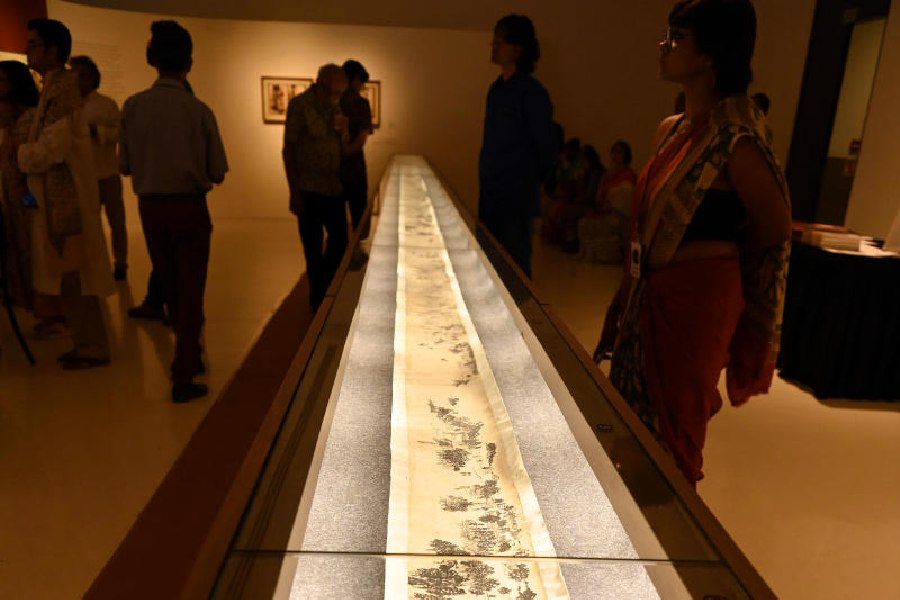
The Scenes from Santiniketan scroll
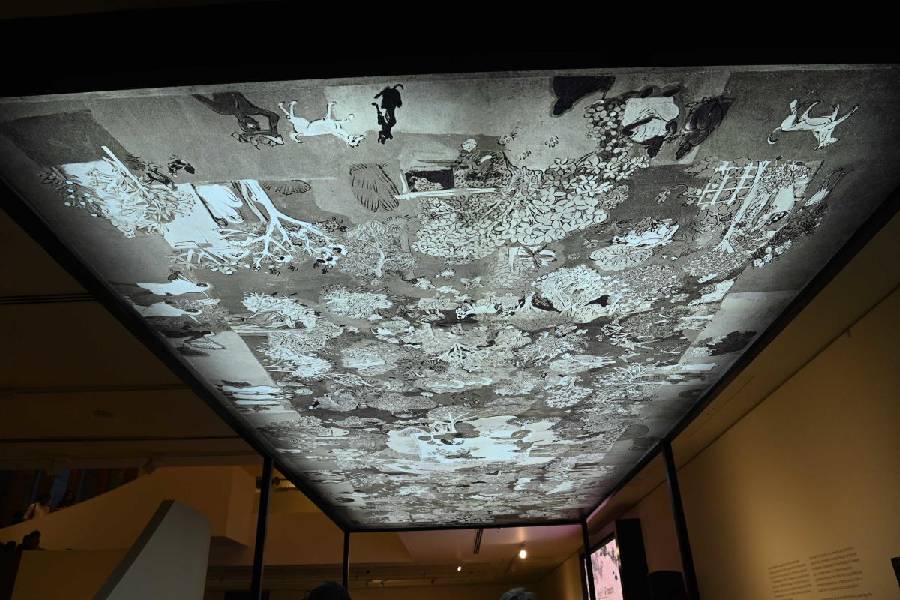
The ceiling mural
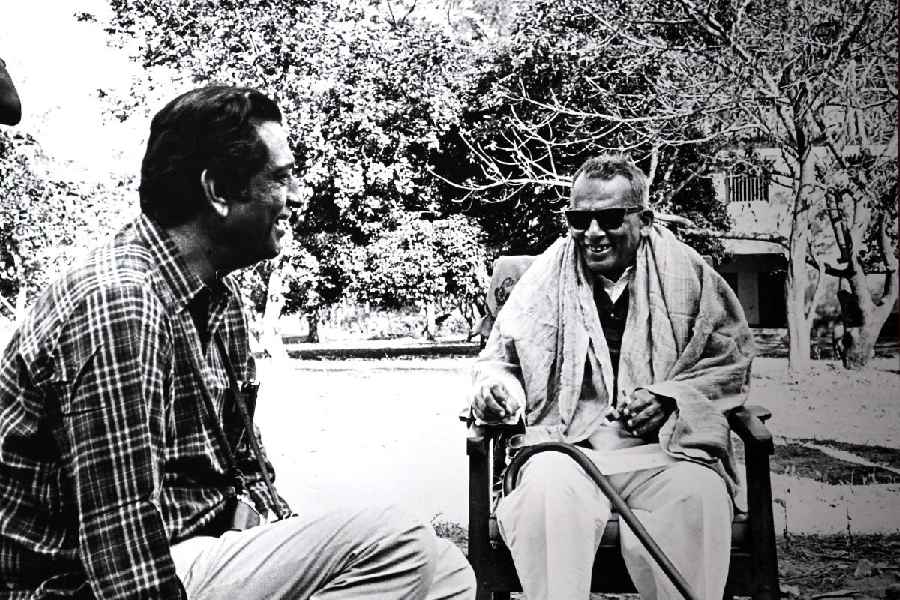
Satyajit Ray with Benodebehari Mukherjee
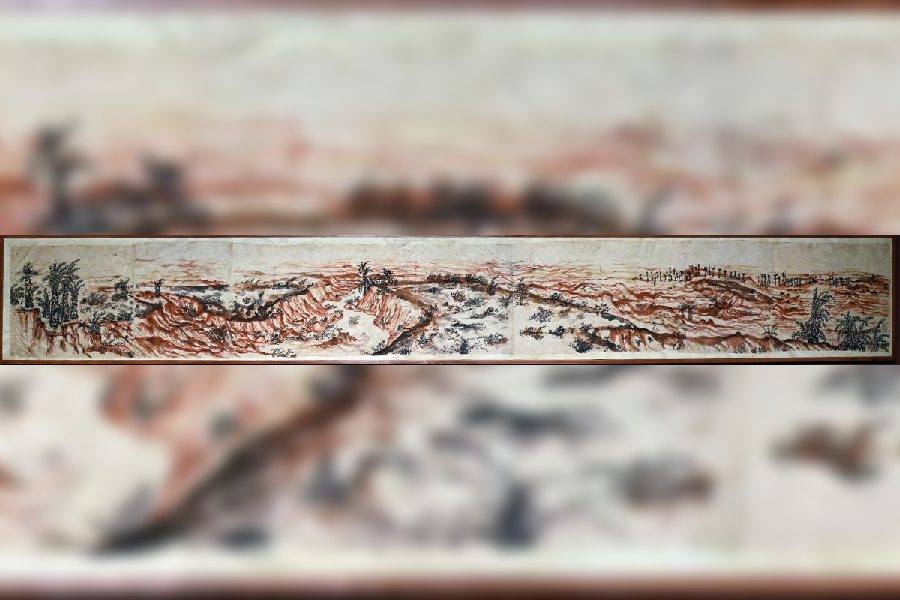
Fragments of other scrolls on display at the exhibition
Pictures: Rashbehari Das





